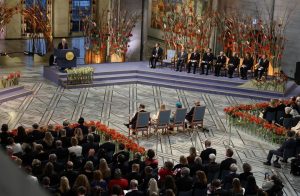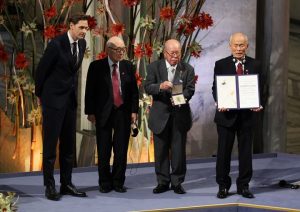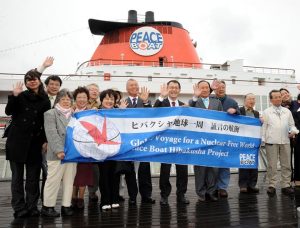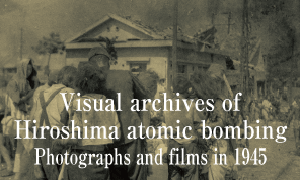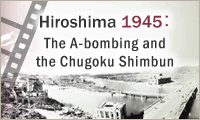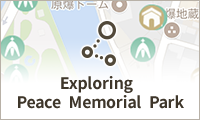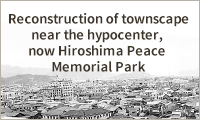Documenting Hiroshima 80 years after A-bombing: From August 6, 1945 to 2025 — In December 2024, Nihon Hidankyo awarded Nobel Peace Prize
Jun. 15, 2025
‘Hibakusha have demonstrated through their witness testimonies that nuclear weapons must never be used again’
A-bomb survivor testimonies contribute to humanity
by Michio Shimotaka, Staff Writer, and Kyosuke Mizukawa, Senior Staff Writer
On December 10, 2024, the Japan Confederation of A- and H-Bomb Sufferers Organizations (Nihon Hidankyo), a national organization of A-bomb sufferers, was awarded the Nobel Peace Prize in Oslo, Norway. The Norwegian Nobel Committee explained that A-bomb survivors (hibakusha) demonstrated through their witness testimonies that nuclear weapons must never be used again. Amid growing concerns about the use of nuclear weapons, the group’s history of working to convey the reality of the atomic bombings drew attention from around the world. In anticipation of a future without A-bomb survivors, Terumi Tanaka, 93, a co-chair of the Nihon Hidankyo organization who lives in Niiza City, Saitama Prefecture, gave his historic remarks, vigorously calling on future generations to continue the work of the survivors’ movement.
Terumi Tanaka speaks at award ceremony, calls for continuation of survivors’ movement
On December 10, 2024, amid bitter cold weather that reached a daily high of only minus-4 degrees Celsius, fanfare reverberated in Oslo City Hall in Norway as the start of the Nobel Peace Prize award ceremony was announced to the audience. The three co-chairs of the Nihon Hidankyo organization entered on foot or in wheelchair from the rear of the venue, rose to the stage, and sat down side by side.
“You refused to sit in silent terror as the great powers led us through long periods of nuclear armament. You stood tall and shared your unique personal testimony with the entire world,” said Jørgen Watne Frydnes, 40, chair of the Norwegian Nobel Committee, who extended his praise for the group’s “contribution to humanity.” When an award certificate was handed to another of the co-chairs Toshiyuki Mimaki, 83, a resident of the area of Kitahiroshima-cho in Hiroshima Prefecture, and the Peace Prize medal was presented to the other co-chair Shigemitsu Tanaka, 84, a resident of Nagasaki City, a resounding applause arose.
After a musical interlude, Terumi Tanaka headed to the podium and spoke about his constant efforts to craft his remarks in an assortment of locations, including on the train and in bed. Although the Peace Prize was dedicated to “all survivors,” as Mr. Frydnes put it in his remarks, Mr. Tanaka wrote the speech based on his own personal experience as a hibakusha and on the history of Nihon Hidankyo.
Mr. Tanaka opened his remarks by saying, “I am one of the survivors of the atomic bombing of Nagasaki,” and conveyed to the audience the tragedy he had witnessed in August 1945, when he was 13 years of age. Five of his relatives were included in the massive number of A-bomb victims. He added, “I found the charred body of one aunt at the remains of her house, along with the body of her grandson, a university student. The deaths I witnessed at that time could hardly be described as human deaths.”
Eleven years after the bombings, in August 1956, Nihon Hidankyo was formed. Its establishment took place on the second day of the second World Conference against Atomic and Hydrogen Bombs held in Nagasaki City. Mr. Tanaka took part in the conference while he was on a return home from Tokyo. While conducting research at Tohoku University, he played a central role in the activities of Nihon Hidankyo starting in the 1970s after he was assigned to the post of acting director. He introduced the two pillars of the movement — compensation from the national government for A-bomb damages, and elimination of nuclear weapons — while also sharing the reality of the atomic bombings’ impact with people around the world.
In the past, Nihon Hidankyo would send delegations of around 50 members to international conferences held overseas. Recently, however, the organization has been able to send only a few delegates. The disbanding of local A-bomb survivor groups continues apace. Referring to the fact that the average age of A-bomb survivors now exceeds 85 years and that his group’s movement has reached a turning point, Mr. Tanaka made an appeal to the audience in his remarks. “From now on, I hope that the next generation will find ways to build on our efforts and develop the movement even further,” he said.
At the award ceremony venue, in addition to the Nihon Hidankyo delegation including A-bomb survivors living overseas and diplomats from numerous nations, there were also young citizens hoping to achieve the abolition of nuclear weapons, including High School Peace Ambassadors from Japan. The young attendees became aware that the purpose of Nihon Hidankyo’s receipt of the prize was to promote the continuation of the group’s activities, given the aging of A-bomb survivors at a point in time when the group’s work is only partway finished.
As an example of initiatives undertaken by the next generation, Mr. Tanaka referred to the non-profit organization No More Hibakusha Project – Inheriting Memories of the A-and H-Bomb Sufferers, a group involved in the collection of materials relating to Nihon Hidankyo, and expressed his hope that the NPO would put all its energies into broadening the understanding of the reality of the bombings, making use of such materials as the testimonies of A-bomb survivors’ experiences in the atomic bombings and records of the movement. Calling for solidarity across generations, Mr. Tanaka concluded his 22-minute remarks with the words, “Let us work together for a human society, in a world free of nuclear weapons and of wars!”
In the Oslo city limits, in conjunction with the holding of the award ceremony, a special exhibition featuring documentary photographs and ”A-bomb drawings” of the atomic bombing began. Mr. Frydnes, who is young enough that he could be Mr. Tanaka’s grandson, remarked that it was the responsibility of all of humanity to carry forward the experiences and the messages of survivors. After returning to Japan following the ceremony, Mr. Tanaka greeted the 80th year after the atomic bombings with renewed resolve. “We must launch a major movement to prevent the collapse of the nuclear taboo.”
In ad-lib comment, emphasized lack of national compensation for A-bomb sufferers
Reflecting on his speech at the ceremony, Mr. Tanaka recalled that he was not nervous at the time and was able to objectively observe himself speaking. He described how he had repeatedly practiced his acceptance speech and how, when reading the prepared manuscript again prior to the ceremony, he had suddenly felt that the audience might not understand if he read the manuscript exactly as it was. That is why he decided to add an ad-lib comment during the remarks.
The comment was meant to explain Nihon Hidankyo’s history of seeking national compensation for A-bomb victims given Japan’s responsibility for starting the war. He emphasized in the remarks, “Let me reiterate this point: the Japanese government has made no compensation whatsoever to those who lost their lives.”
In 1957, the year after Nihon Hidankyo’s establishment, the Atomic Bomb Medical Relief Law came into force, which led to the national government starting to provide support to living A-bomb survivors for damages caused by A-bomb radiation. The government, however, would turn its back on any implementation of other compensation for deceased A-bomb victims, described by Nihon Hidankyo as “those who had suffered the most,” such as condolence money and pensions for bereaved families. The government’s stance was based on the “tolerance theory,” which claims that all citizens must equally bear the loss of life and physical suffering in wartime, a theory that Nihon Hidankyo has vigorously opposed.
Regarding his ad-lib comment, Mr. Tanaka said, “I recently believe what I did at that time was because the souls of victims who had died in the atomic bombing without speaking had entered my soul.” With the words “citizens were victimized by war and then abandoned by the government” he hoped to convey the idea that, “This is an issue concerning war, the state, and the people — something that goes beyond a mere domestic matter of Japan.”
In Japan, no compensation was provided for those killed in air raids in the war. If the tolerance of citizens were to be justified for their sacrifices in war, the “mistake” would be repeated by any nation, not only Japan. Mr. Tanaka explained, “It was a ‘let me reiterate’ idea born from a strong plea for a vow of ‘non war’ that goes beyond the abolition of nuclear weapons.”
Nobel Committee Chair concerned about collapse of “nuclear taboo”
In his speech at the award ceremony, Nobel Committee Chair Mr. Frydnes issued a warning to the international community about how, “The world is entering what many analysists characterize as a new, more unstable nuclear age.”
The number of nuclear weapons in nine nuclear-armed nations is estimated to total around 12,000 warheads. Compared to a peak of about 70,000 weapons in 1986 amidst the Cold War era, that number has declined. In recent years, however, the pace of decline has faltered, with nuclear-weapons states focusing on modernization and enhancement of their nuclear forces.
Between the United States and Russia, two nuclear superpowers, the Intermediate-Range Nuclear Forces (INF) Treaty expired in August 2019. And Russia announced suspension of the New Strategic Arms Reduction Treaty (New START), the only nuclear disarmament agreement remaining between the two nations, in 2023. The agreement is scheduled to expire in February 2026.
In his remarks, Mr. Frydnes warned, “Threats to use nuclear arms in ongoing warfare have been made openly and repeatedly.” In cases of Russia’s invasion of Ukraine and the war in Gaza in the Palestinian territories, fought between Israel, a de facto nuclear nation, and the Islamic organization Hamas, the leaders and cabinet members of the nations and territories involved have repeated comments hinting at the possible use of nuclear weapons.
While Mr. Frydnes praised the achievement by A-bomb survivors in the development of a “nuclear taboo,” which defines the use of nuclear weapons as morally unacceptable, he expressed his strong concern that, “The taboo is fragile, and it becomes more so with the passage of time.” Mr. Tanaka spoke about how he shared that sense of crisis, referring to the situations in Ukraine and Gaza with the words, “I am infinitely saddened and angered that the ‘nuclear taboo’ threatens to be broken.”
The Nihon Hidankyo organization has gained particular attention as a Nobel Peace Prize candidate in milestone years since the atomic bombing, such as 1985 and 2005. During Mr. Tanaka’s stay in Oslo, a staff associated with the committee said to him that Nihon Hidankyo had become a candidate for the prize in years ending in five. With that, it was somewhat of a surprise to him for Hidankyo to be awarded the prize in 2024. Nevertheless, Mr. Tanaka said, “We understood it as the committee considering the nuclear situation in the world and wanted to award us the prize before it was too late.”
Continued to speak out despite their suffering
Inhumanity communicated in Japan and internationally
In Nihon Hidankyo’s being awarded the Nobel Peace Prize, the significance was emphasized of A-bomb survivor “testimonies,” which communicate what will happen to humanity caused by the use of nuclear weapons. A-bomb survivors continued to speak out and provide testimonies of their experiences despite their own physical and psychological suffering even through the occupation of Japan, a period in which any mention of the atomic bombings was strictly controlled. There were many such individual predecessors of the movement who died without knowing that the group had been awarded the prize.
In September 1945, the month after the atomic bombings, the General Headquarters of the Allied Forces (GHQ), led by the U.S. military, issued a press code to restrict news coverage and other information related to the atomic bombings. In 1947, Hiroshima City Mayor Shinso Hamai, who experienced the atomic bombing in Hiroshima and died in 1968, announced the first Peace Declaration. In addition, together with other religious leaders, Father Hugo Lassalle, a German priest who died in 1990, conveyed his experiences in the atomic bombings to the world. Those were rare instances of A-bomb survivors having the wherewithal to speak out.
Even after the occupation of Japan ended in April 1952, Japan’s national government failed to provide any assistance and, in words spoken by Mr. Tanaka in his remarks, the A-bomb survivors “spent more than a decade after the bombings in isolation, suffering from illness and hardship in their lives, while also enduring prejudice and discrimination.” The first World Conference against Atomic and Hydrogen Bombs, held in Hiroshima City in 1955, paved the way for the survivors to speak in public. As citizens gathered to collect signatures to ban hydrogen and atomic weapons in a drive that gained momentum as a result of U.S. hydrogen bomb testing taking place at the time, the survivors testified about their experiences in the atomic bombings and the hardships that continued thereafter.
The Nihon Hidankyo organization was formed the next year, in 1956. The first secretary general of the organization, Heiichi Fujii, who died in 1996, felt that the A-bomb survivors’ testimony work “granted everyone the great courage ‘to live.’” With that, Mr. Fujii continued dispatching survivors to gatherings throughout Japan. Nihon Hidankyo also dispatched delegations to conferences and gatherings overseas. Ichiro Moritaki, who was from Hiroshima and died in 1994, and Senji Yamaguchi, who was from Nagasaki and died in 2013, were leaders in that effort.
In addition to Nihon Hidankyo’s activities, in the 1960s, A-bomb survivors also traveled to Western nations, joining as an example the World Peace Pilgrimage, a program first proposed by the American peace activist Barbara Reynolds, who died in 1990. Since 1983, the Hiroshima Peace Culture Foundation, an association affiliated with the city government, has been entrusted with the work of providing testimonies of A-bomb experiences to students on school field trips. That role was undertaken by, among others, Miyoko Matsubara, known as one of the so-called “Hiroshima Maidens,” who underwent skin graft surgery for burn scars and other treatments and died in 2018.
When the Peace Culture Foundation began a project to produce videos of A-bomb survivors’ testimonies in the 1980s, survivors of the atomic bombings from the Korean peninsula such as Kan Moonhee, who served as chair of the Committee Seeking Measures for the Korean A-bomb Victims and died in 2014, took part in the video recording. Lee Sil Gun, then chair of the Council of Atomic-bombed Koreans in Hiroshima who died in 2020, dedicated himself to sharing his A-bomb experiences in the project.
Starting in 2008, the NGO Peace Boat started plans for a voyage by boat during which A-bomb survivors would recount their experiences in the atomic bombings at each port country. Survivors living overseas, such as Kwak Kwi Hoon, who was from South Korea and died in 2002, and Takashi Morita, who was from Brazil and died in 2024, also joined the journey. Mitsuo Kodama, who joined the voyage in 2010 and died in 2020, underwent more than 20 surgeries for stomach and skin cancers by the time he died, after his continued efforts to convey the inhumane nature of A-bomb radiation, which continues to afflict A-bomb survivors today.
“I felt as if I was shouting into an abyss of rough seas amid darkness,” said Shizuko Abe, 98, an A-bomb survivor and resident of Hiroshima’s Minami Ward, as she reflected on her feelings about the period when she began to speak up. Ms. Abe was involved in the A-bomb survivor movement from early on, later serving as a witness of the atomic bombing for the Hiroshima Peace Culture Foundation.
At the award ceremony, in a time marked by continued attempts to justify the possession of nuclear weapons, Nobel Committee Chair Mr. Frydnes emphasized, “We could listen to those who claim it is pointless, or instead, take inspiration from the Hibakusha – from their stamina and persistence.”
Japanese government turns its back on TPNW
On January 8, 2025, a month after Nihon Hidankyo was awarded the Nobel Peace Prize, eight Nihon Hidankyo board members, including Mr. Tanaka, visited the Japan Prime Minister’s Official Residence. They were invited by Prime Minister Shigeru Ishida, who said he wanted “to pay tribute to their achievement.”
What drew attention was how the prime minister would reply to the group’s request to attend the meeting of states parties to the Treaty on the Prohibition of Nuclear Weapons (TPNW). The TPNW, which prohibits any act involving nuclear weapons, including use and possession, was established in 2017 under the leadership of non-nuclear nations. In his remarks at the award ceremony, Mr. Tanaka referred to the treaty, describing how his group and others were “overjoyed” at the TPNW’s adoption. Japan’s government has not yet ratified the TPNW due to its reliance on nuclear deterrence provided by the United States, but Nihon Hidankyo has demanded that the government attend the third meeting of states parties to the TPNW, to be held in March, as an observer.
In the meeting, open to the public only at its beginning, Mr. Ishiba praised Nihon Hidankyo’s being awarded the prize as, “Very significant. I sincerely appreciate your many years of efforts.” However, he did not mention whether Japan would participate in the meeting as an observer. Later, the government made the decision to not attend, with no nuclear-armed nations or member nations of the North Atlantic Treaty Organization (NATO) participating either. That gave the world the impression that the current international situation could undermine the “nuclear taboo” and embolden the cycle of “nuclear for nuclear” retaliation.
In his award ceremony remarks, Chair Mr. Frydnes made the plea, “It is naïve to believe our civilization can survive a world order in which global security depends on nuclear weapons.” In March this year, the International Group of Eminent Persons for a World Without Nuclear Weapons, a group established on the basis of leadership by the Japanese government, also announced its recommendation that, “All nations must continue working to move away from dependence on nuclear weapons.” However, there has not been any widespread debate about the future that humanity should create to avoid annihilation from nuclear war.
Aging local A-bomb survivor organizations disbanded in numerous prefectures
Atomic Bomb Survivor’s Certificate holders, around 100,000 people, reach average age of 85.58 years
According to Japan’s Ministry of Health, Labour and Welfare, 106,825 people were in possession of the Atomic Bomb Survivor’s Certificate in fiscal 2023 (as of the end of March 2024), a decline of 6,824 people from the previous year. The number represents a decrease of 70 percent compared with the 372,264 number recorded in fiscal 1980, which was the largest number of holders after issuance of the certificate began in 1957. The average age of the holders at that time was 85.58 years, an increase of 0.57 years compared with the previous fiscal year. Based on calculations by the Chugoku Shimbun, in fiscal 2024, the number of certificate holders was 99,343 people, dipping below 100,000.
According to the Radiation Effects Research Foundation (RERF; located in Hiroshima City’s Minami Ward), increased risks of developing solid cancers, such as of the stomach, lung, and liver, as well as leukemia are observed among A-bomb survivors, with radiation effects also identified in stroke, heart disease, and other such health issues. As of the end of March 2024, 5,165 individuals receive special medical subsidies (154,090 yen per month at present), provided to survivors recognized as suffering from A-bomb diseases, with 86,921 people receiving health care allowances (37,900 yen per month at present), which are paid to those with other specific diseases or conditions.
Due to the decrease in number and aging of A-bomb survivors, regional survivor organization members of the national Nihon Hidankyo are being disbanded one after the other. Those organizations were established in various cities and prefectures throughout Japan, mainly in the 1950s. In the past, the Nihon Hidankyo organization included member groups from all 47 prefectures in Japan, but at the time it was awarded the Nobel Peace Prize, only groups representing 36 prefectures remained. A member organization in Hokkaido, one of those that had remained, concluded its activities in March this year.
“Ten years from now, there may only a handful of us able to give testimony as firsthand survivors,” said Mr. Tanaka in his acceptance speech at the award ceremony. In a number of locations across Japan, people continue to make efforts to sustain the movement, by adding second-generation A-bomb survivors or supporters to the member ranks or forming organizations for second-generation survivors.
(Originally published on June 15, 2025)

